Gemstones are mineral deposits that can be found deep underneath the earth crust; some can also be in the form of organic materials (e.g. pearls, which are found in oysters). They are usually desired because of their rarity, commercial value and brilliance or beauty. Diamond is the hardest known substance in the world, which makes it the hardest known gemstones in the world. This particular gemstone also happens to be the most popular one all across the world, as well as one of the rarest.
HOW ARE DIAMONDS FORMED?
Diamonds are formed deep beneath the earth’s crust when pure carbon is subjected to extreme heat and pressure. Diamond is one of the only two natural forms of pure carbon (the other one is graphite, a much softer amorphous version), which can only be found in 35 countries across the world; especially in areas that have once experienced volcanic action or volcanic eruptions. This is because such sites tend to have the necessary raw materials and facilitating physical and geological conditions needed for diamond formation.

The process of diamond formation usually takes a long time in nature (we’re talking millions and even billions of years, depending on geological conditions, as well as other conditions). This process usually occurs when atoms of pure carbon atoms are arranged tightly in a rigid crystal lattice structure, giving rise to the remarkable hardness of diamonds. This situation also results in high difficulty of interference or penetration by other elements or chemical compounds like boron, nitrogen and hydrogen.
However, the fact that such elements cannot easily get into the diamond’s crystal lattice does not mean that they cannot get into it at all. The interference of these elements usually leads to the formation of colored diamonds, which come in different shades of colors such as orange, yellow, purple, blue, green, red and black (amongst others); although, green diamonds are usually formed as a result of exposure to radiation, black diamonds are generally formed due to the exposure of diamonds to graphite during their formation process and no one seems to know the exact reason why red diamonds occur in nature (only that their formation is not due to the occurrence of any sort of known flaw).
Apart from color, there are other ways diamonds can be categorized (e.g. their point of origins).

HOW TO CATEGORIZE DIAMONDS BASED ON POINT OF ORIGIN
Diamonds can be grouped into different categories based on where they are from or, quite specifically, based on the political situation of the area where they have been mined. This is because there are certain countries with significant deposits of diamonds and a whole lot of political upheaval. Many of this kind of countries are war-torn; experiencing civil unrest, with several casualties. In some of such countries, groups that oppose the legitimate government may discover or seize control of diamond mines. Then, they’d mine their own diamonds and sell them for money; which is then pumped subsequently, into the war.
This kind of groups often use the money they acquire from the sale of the mined diamonds to buy weapons and ammunitions, which they use to further their cause, wrestle control out of the government’s hands and terrorize people. Many lives may be lost as a result of such activities.
Due to this situation, diamonds can be categorized into two distinct groups, which are:
- Blood diamonds
Blood diamonds, which are also known as conflict diamonds, are diamonds which are usually mined illegally or through illegitimate means (or by illegitimate forces). But the concept of blood diamonds goes beyond just any kind of legitimacy. Blood diamonds are so termed because they refer to diamonds that are sold or traded in order to purchase weapons and ammunitions, or otherwise further the aims of destructive anti-government forces; particularly in areas and countries where there is war or civil unrest.
Decades ago, there used to be quite a lot of blood diamonds – or conflict diamonds – in the global gemstone trade industry. However, the United Nations and other global institutions, along with the governments of several countries, have taken important steps to curtail this situation. Over the past decade alone, several restrictions – which were already in place – have been enforced extensively, in order to eradicate the trade of blood diamonds.
Some of these efforts were in response to the widely acclaimed, award-winning and deeply emotional movie titled Blood Diamond, which was released in 2006. The movie stars the living legend, Leonardo DiCaprio, and Djimon Hounsou amongst others, and it sheds a light on the dire situation of things in Sierra Leone – where diamonds were being mined by opposition forces; who used the money acquired from the sale of the diamonds to further the war – by following a man named Solomon, who is captured and forced to work in a diamond mine. The movie also follows the experiences of his family.
- Non-conflict diamonds
Non-conflict diamonds are legitimate diamonds, obtained from legal mines by those who have the legal authorization to obtain them. These kinds of diamonds are usually sold openly, and they make up over 90 percent of the diamonds in the global gemstone trade markets today.
Non-conflict diamonds are usually differentiated from blood diamonds through the presence – and validation – of certification, which all legitimate diamonds must have, as a result of the Kimberly process; a process in which legitimate diamonds are fitted with certification tags by means of laser technology.
IS BLOOD DIAMOND A TRUE STORY?
When the movie, Blood Diamond, was released, it shook the world. This is because of its very real and emotional message, as well as the brilliant acting performances from its amazing cast. However, another reason while the movie struck such a deep chord with many people across the world is that, while Solomon Vandy and the rest of the characters were fictional, the occurrences in the film were based on experiences that were very much real for a lot of Sierra Leone citizens during the country’s civil war, which took place from 1991 to 2002.

